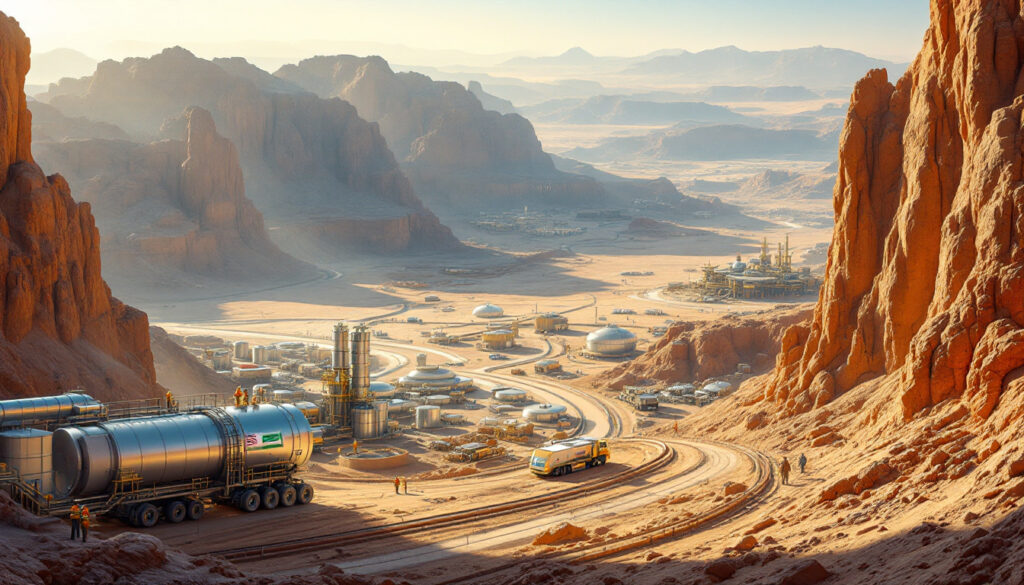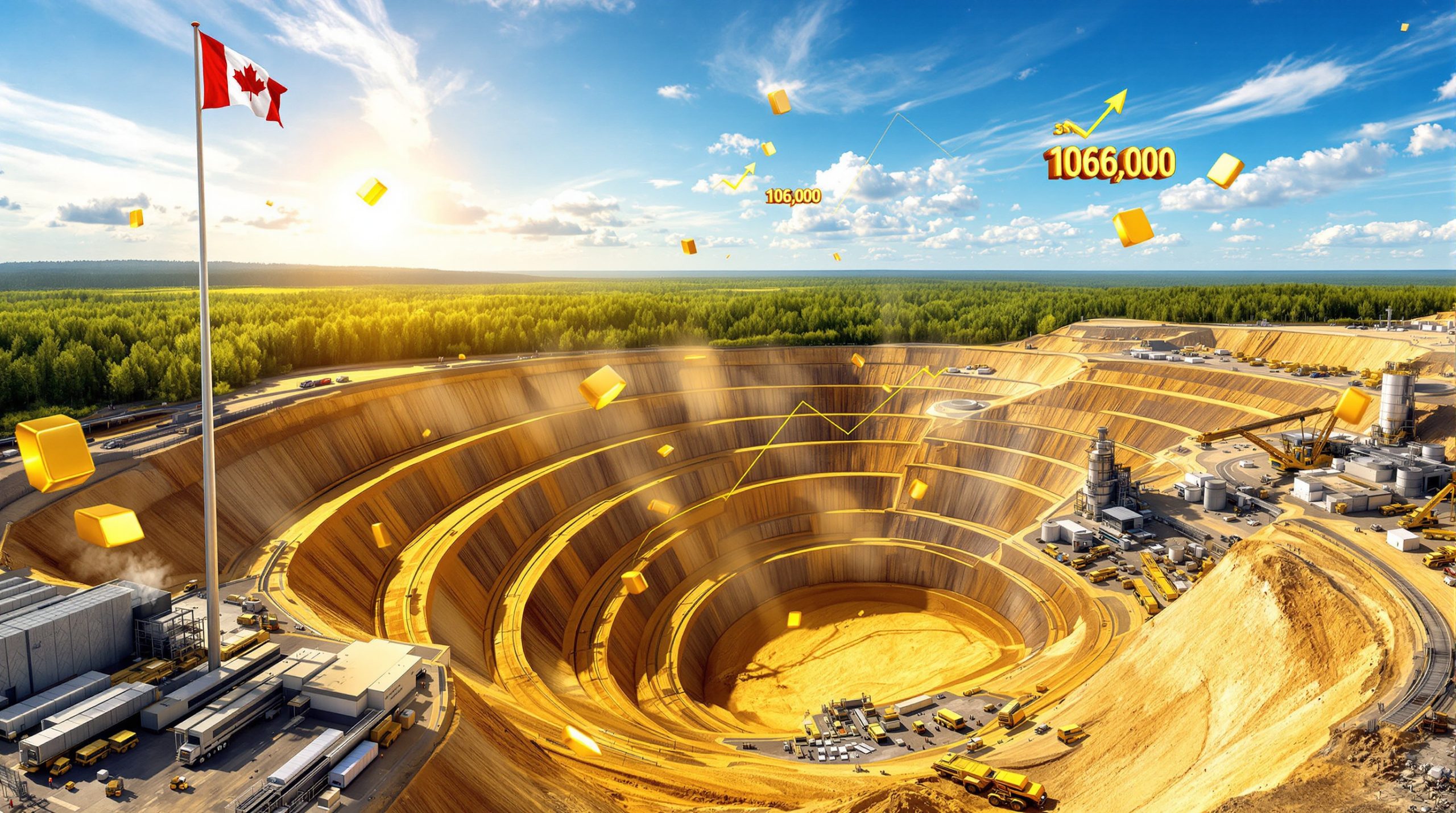Saudi Arabia and US Mining Cooperation: Building a Strategic Partnership for the Future
The collaboration between Saudi Arabia and the United States in mining and mineral resources represents a significant shift in bilateral relations beyond traditional oil and defense cooperation. As Saudi Arabia sits on an estimated $2.5 trillion worth of mineral reserves, the kingdom is actively courting international partnerships to unlock this vast potential as part of its Vision 2030 economic diversification plan. Furthermore, understanding the global commodities insights is crucial for comprehending the significance of this partnership.
Saudi Arabia's Untapped Mineral Wealth
Saudi Arabia possesses extraordinary mineral resources that have been largely overshadowed by its petroleum industry. Recent geological surveys have revealed mineral reserves valued at approximately $2.5 trillion (SR9.38 trillion) as of 2024—a figure that has doubled from previous estimates just a year earlier.
The kingdom's resources extend far beyond hydrocarbons, with significant deposits of rare earth elements (REEs) critical for modern technologies. These deposits are strategically located in regions such as Jabal Sayid and Al-Hajjar, covering exploration zones spanning 4,788 km².
Dr. Ibrahim Al-Nasser, senior geologist with the Saudi Geological Survey, notes: "Saudi Arabia's geological formations have preserved extraordinary deposits of rare earth elements that remain virtually untapped. The concentration levels in some regions rival those found in established mining areas globally."
Unlike traditional mining powers, Saudi Arabia offers unique advantages through its:
- Relatively unexplored geological formations
- Modern infrastructure and logistics networks
- Strategic location between major markets
- Significant financial resources for capital-intensive development
- Stable regulatory environment
Vision 2030: Mining as a Pillar of Economic Transformation
Mining represents a central component of Saudi Arabia's Vision 2030 economic diversification strategy, designed to reduce the kingdom's historic dependence on oil revenues. Crown Prince Mohammed bin Salman has identified mining as the "third pillar" of Saudi industrial growth, alongside petroleum and petrochemicals.
The mining sector development aims to:
- Create over 200,000 direct and indirect jobs in the mining ecosystem
- Contribute approximately 3% to Saudi GDP by 2030 (up from less than 0.5% currently)
- Establish downstream industries for value-added processing
- Attract $170 billion in foreign direct investment by 2030
- Position Saudi Arabia as a global mining hub
Saudi Arabia's mining ministry has already taken significant steps by issuing exploration licenses covering thousands of square kilometers to international operators since 2022. These licenses target areas with promising geological indicators for rare earths, copper, gold, and other strategic minerals. The mining technology transformation is expected to play a crucial role in this development.
The Proposed US-Saudi Mining Partnership
The Saudi Cabinet has authorized the Ministry of Industry and Mineral Resources to negotiate a Memorandum of Understanding (MOU) with the US Department of Energy focused on Saudi Arabia and US mining and mineral resources cooperation. This prospective agreement aligns with the upcoming diplomatic engagement between the two nations, including a planned visit by former US President Donald Trump.
Core Elements of the Proposed MOU
The framework is expected to encompass:
- Technology exchange for advanced mineral exploration and extraction
- Joint development of processing capabilities for critical minerals
- Strategic investments in mining operations and processing facilities
- Knowledge sharing on sustainable mining practices
- Supply chain integration for critical minerals
- Research collaboration on mineral processing innovations
For the United States, this partnership represents an opportunity to secure access to critical minerals outside China-dominated supply chains. For Saudi Arabia, American technological expertise and investment capital offer pathways to accelerate mining sector development.
Dr. Robert Johnson, mining economist at the Colorado School of Mines, explains: "The US brings world-class expertise in mineral exploration technology, processing innovations, and sustainable mining practices. Saudi Arabia offers exceptional geological potential, financial resources, and strategic location. This complementary relationship could redefine global mineral supply chains."
Recent Developments in Saudi Mining
Saudi Arabia has made significant strides in expanding its mining footprint in recent years:
| Development | Details | Significance |
|---|---|---|
| License Issuance | Exploration permits granted since 2022 covering 4,788 km² | Opens previously restricted areas to international operators |
| Manara Minerals Formation | Joint venture between sovereign wealth fund and Ma'aden | Creates investment vehicle for international mining assets |
| Vale Base Metals Stake | $26 billion acquisition of 10% stake | Secures position in global copper and nickel supply |
| Rare Earth Partnerships | Ongoing talks with MP Materials, Lynas, Neo Materials | Seeks technology transfer for processing capabilities |
| Ajlan & Bros Consortium | Saudi-Chinese partnership with Zijin Mining | Establishes regional exploration capabilities |
Ma'aden, Saudi Arabia's state mining champion, has been particularly active in pursuing partnerships with global rare earth leaders including:
- MP Materials (US) – The operator of Mountain Pass, America's only rare earth mine
- Shenghe Resources – A leading Chinese rare earth processor
- Lynas Rare Earths – Australia's primary rare earth producer
- Neo Performance Materials – Canadian rare earth processor and magnet manufacturer
In a particularly significant move, Manara Minerals—the joint venture between Saudi Arabia's sovereign wealth fund and Ma'aden—acquired a 10% stake in Vale Base Metals worth $26 billion. This investment immediately positions Saudi Arabia as a major player in global copper and nickel production, both essential metals for the clean energy transition.
Strategic Importance in Global Mineral Supply Chains
The US-Saudi mining partnership addresses growing concerns about concentrated supply of critical minerals, particularly rare earth elements where China currently dominates approximately 85% of global processing capacity.
"Diversification of critical mineral supply chains isn't just an economic consideration—it's increasingly a national security imperative for Western nations," explains Michael Sullivan, former mining security advisor to the US Department of Defense.
This cooperation creates several strategic advantages:
- Supply chain resilience: Establishing alternative sources for minerals needed in clean energy technologies
- Geopolitical balance: Reducing dependence on dominant suppliers in certain mineral categories
- Industrial security: Ensuring consistent access to materials crucial for defense and high-tech manufacturing
- Price stability: Potentially moderating price volatility through expanded production
- Technology leadership: Combining US innovation with Saudi resources for next-generation mining techniques
According to the International Energy Agency, demand for critical minerals used in clean energy technologies is projected to grow by as much as 400% by 2040. Establishing secure, sustainable supply chains outside of traditional sources represents a strategic priority for both nations. For investors seeking to understand this sector better, a comprehensive mining stocks guide can provide valuable insights.
Economic Benefits and Investment Landscape
The economic impact of the US-Saudi mining partnership extends far beyond resource extraction. The initiative is expected to generate:
- Employment growth: Creation of specialized jobs in exploration, extraction, and processing
- Industrial development: Establishment of downstream industries utilizing locally sourced minerals
- Export diversification: Expanded mineral exports beyond crude oil and petroleum products
- Technology transfer: Enhancement of Saudi Arabia's industrial capabilities through knowledge sharing
- Investment attraction: Increased foreign direct investment in Saudi Arabia's mining sector
The partnership particularly benefits from Saudi Arabia's $620 billion Public Investment Fund (PIF), which has demonstrated willingness to make significant investments in mining assets, as evidenced by the Vale Base Metals transaction.
For investors, the Saudi mining sector offers unique advantages:
- Financial incentives: Tax holidays and import duty exemptions for qualifying projects
- Infrastructure support: Government-backed development of transportation and energy infrastructure
- Regulatory clarity: Modernized mining law introduced in 2020 with transparent licensing processes
- Resource potential: Access to largely unexplored mineral provinces with high discovery potential
- Market proximity: Strategic location between European and Asian markets
Environmental Sustainability and Technological Innovation
Both nations recognize that modern mining must incorporate environmental sustainability. The cooperation framework is expected to address:
Water Conservation Technologies
Mining in Saudi Arabia's arid environment presents unique challenges. The partnership aims to implement:
- Advanced water recycling systems achieving 90%+ water reuse rates
- Dry processing technologies that minimize water consumption
- Desalination integration for mining operations near coastal areas
- Digital monitoring systems for real-time water management
ESG Standards and Practices
The collaboration will likely incorporate robust environmental, social, and governance standards:
- Comprehensive environmental impact assessments before project approval
- Community engagement protocols emphasizing local benefits
- Site rehabilitation and reclamation requirements with financial guarantees
- Greenhouse gas reduction targets for mining operations
- Independent monitoring and reporting mechanisms
Addressing mining ESG challenges will be crucial for the long-term sustainability of this partnership.
Technological Innovation
Technology transfer represents a core element of the partnership, focusing on:
- AI-powered exploration techniques to improve discovery rates
- Automated mining systems to enhance safety and efficiency
- Advanced processing methods to reduce waste and emissions
- Digital twins of mining operations for optimization
- Remote sensing for environmental monitoring
Future Outlook and Challenges
The long-term prospects for US-Saudi mining cooperation appear promising, but several challenges require attention according to recent mining industry predictions:
Long-term Success Factors
- Infrastructure development: Building transportation networks to connect remote mining sites
- Workforce development: Training specialized personnel for high-tech mining operations
- Research capabilities: Establishing R&D centers focused on mining innovation
- Regulatory harmonization: Aligning standards and practices across jurisdictions
- Market development: Creating demand for processed minerals beyond raw extraction
Key Challenges
- Water scarcity: Managing water resources in one of the world's most water-stressed regions
- Technical expertise: Developing local knowledge base for specialized mining operations
- Market volatility: Navigating commodity price fluctuations affecting investment returns
- Geopolitical tensions: Balancing multiple international partnerships and interests
- Climate considerations: Operating efficiently in extreme temperature environments
"The success of Saudi Arabia's mining ambitions will depend heavily on their ability to attract not just capital, but also human talent and technological expertise," notes Sarah Richards, mining analyst at Global Resource Partners. "Building a competitive mining ecosystem requires decades of sustained investment and development."
Expert Perspectives on US-Saudi Mining Cooperation
Industry experts offer varied perspectives on this emerging partnership:
On resource potential:
"Saudi Arabia's geological formations share characteristics with major mineral-producing regions in Australia and parts of Africa, yet have seen only a fraction of the exploration activity. The discovery potential is extraordinary," explains Dr. Thomas Williams, economic geologist at the University of Arizona.
On investment outlook:
"This represents a high-risk, high-reward scenario for early investors. The geological potential is undeniable, but building a mining sector at this scale and speed presents significant execution challenges," cautions Maria Chen, mining sector analyst at Goldman Sachs.
On geopolitical implications:
"The US-Saudi mining partnership adds a new dimension to bilateral relations beyond the traditional oil-for-security arrangement. It creates mutual interests in critical technology supply chains that could prove more durable than petroleum ties," observes Ambassador James Porter, former US envoy to Saudi Arabia.
Key Questions About the Partnership
What specific minerals form the core focus of cooperation?
While the full scope remains under negotiation, the partnership will likely prioritize:
- Rare earth elements (particularly neodymium and dysprosium for magnets)
- Copper (essential for electrification)
- Lithium, cobalt, and nickel (battery materials)
- Phosphate (agricultural applications)
- Gold and precious metals
How does this agreement benefit the United States?
The United States gains several advantages:
- Access to alternative sources of critical minerals
- Reduced dependence on Chinese-dominated supply chains
- Investment opportunities for US mining technology companies
- Enhanced diplomatic ties with a strategic regional partner
- Potential stabilization of critical mineral prices through expanded supply
Will Saudi Arabia's mining sector development affect global mineral prices?
Increased production capacity from Saudi Arabia could help moderate price volatility for certain minerals, particularly those currently concentrated in few producing regions. However, the impact depends on:
- Scale and timeline of Saudi production capacity development
- Global demand growth rates for specific minerals
- Production decisions by existing major producers
- Success of exploration programs in identifying economically viable deposits
How does this fit with Saudi Arabia's other international mining partnerships?
Saudi Arabia has pursued a deliberate strategy of engaging with multiple international partners:
- Chinese companies for exploration and development expertise
- Australian firms for technical knowledge and training
- Canadian companies for environmental standards and sustainability practices
- European partnerships for processing technology
This diverse approach allows Saudi Arabia to access various technologies and methodologies while avoiding over-dependence on any single partner nation.
Why This Partnership Matters Beyond Mining
The US-Saudi mining collaboration represents more than just resource development—it signifies a strategic realignment in bilateral relations. As Saudi Arabia diversifies beyond oil and the United States seeks to secure critical mineral supply chains, this partnership creates mutual interests in emerging technologies and industrial development.
For companies involved in mining technology, mineral processing, and downstream manufacturing, Saudi Arabia offers a rapidly developing market with significant financial resources and governmental support. For Saudi Arabia, the partnership provides access to world-class expertise and technology needed to realize its ambitious Vision 2030 goals.
The ultimate success of this cooperation will depend on sustained commitment from both governments, effective knowledge transfer, and the ability to overcome the unique challenges of developing a world-class mining sector in Saudi Arabia's challenging environment.
"What makes this partnership particularly significant is its potential to create entirely new supply chains for critical minerals at a time when technology-intensive industries face increasing resource constraints," concludes Dr. Elizabeth Warren, resources economist at MIT. "If successful, it could help reshape global mineral markets for decades to come."
Ready to Stay Ahead of the Next Major Mining Discovery?
Keep your finger on the pulse of global mining developments by subscribing to Discovery Alert's proprietary Discovery IQ model, delivering instant ASX mineral discovery notifications straight to your inbox. Visit the Discovery Alert discoveries page to understand why major mineral discoveries can generate substantial returns and begin your 30-day free trial today.




